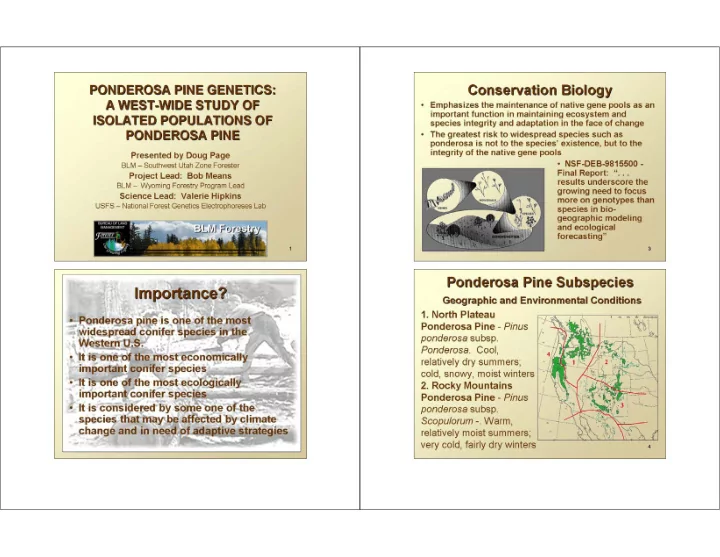

4 / 5 NOTES: Modern forestry research identifies four different taxa of Ponderosa Pine, with differing botanical characters and adapted to different climatic conditions. These have been termed "geographic races" in forestry literature, while some botanists historically treated them as distinct species. In modern botanical usage, they best match the rank of subspecies, but not all of the relevant botanical combinations have been formally published. The distributions of the subspecies, and that of the closely related Arizona Pine ( Pinus arizonica ) are shown on the map. The numbers on the map correspond to the taxon numbers above and in the table. The base map of the species range is from Critchfield & Little, Geographic Distribution of the Pines of the World , USDA Forest Service Miscellaneous Publication 991 (1966). Before the distinctions between the North Plateau race and the Pacific race were fully documented, most botanists assumed that Ponderosa Pines in both areas were the same
22 NOTES: 650 BP (1350AD) abrupt change to persistently less arid conditions lasts until 1920 AD. 1050 to 650 BP – Medieval Climate Anomaly (Medieval Warm Period) – severe multi-decadal droughts – Wah Wah PIPO established at this time. 8,000-4,000 – Altithermal Period (mid-Holocene) period of warmer conditions. 10,000 BP – Insolation maximum – Early Holocene – most solar radiation, i.e. hot and dry minimal effective summer moisture. PIPO recorded in Yellowstone NP, PIPO found in packrat middens in Sheep Range S. NV
23 NOTES: Charlet 2007 - Aliso 24, pp. 31–61, 2007, Rancho Santa Ana Botanic Garden (David Charlet is professor of biology, Community College Southern Nevada, Henderson, Nevada) Extinction comes when the environment changes sufficiently to approach or exceed the environmental tolerances of the species or population. Invasion/extinction plays out primarily in the juvenile phase. Adults of many species have broader environmental tolerances. Extinction proceeds from the reduction or cessation of recruitment followed by the senescence of existing adults. This is generally a gradual process with populations disappearing from all but the most favorable sites with the ultimate elimination from the latter by stochastic processes (incl. climate variability or disturbance).
27 NOTES: Var. scopulorum movement in the SW and up thru Wyoming is documented thru packrat middens for the past 12,000 years. Basically nothing is known about var. ponderosa – it is thought to have come from Pleistocene refugia along the Pacific coast. Because of the finding of the relationship between Wenatchee (less heterozygous) and the UT (Wah Wah) genotype (more heterozygous) there is already some credence to this Charlet’s hypothesis – the greater the heterozygosity, generally the closer to the home refugia. 28 NOTES: SNP = "Single Nucleotide Polymorphisms” A SNP (pronounced snip) is the difference in the DNA between individuals of a species. The SNP marker is actually just a change of a single base (or nucleotide) between the individuals. So at any one SNP, some individuals could have an 'A' base, others 'T', others 'C', etc. Because there are so many possible SNP markers, with a lot of lab work (and having matching information on morphological or physiological traits from the same trees), the SNPs could be tied to adaptive traits (so SNPs would be able to measure the plants ability to respond to the environment).
Recommend
More recommend